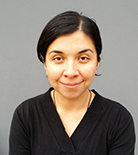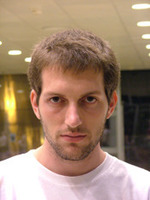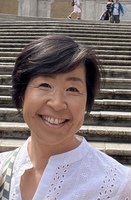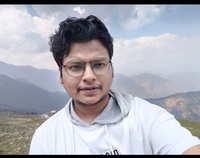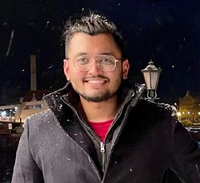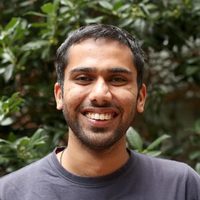Varun Jampani
Advisor:
Peter Vincent Gehler
I am working on leveraging machine learning techniques for better inference in computer vision applications. The main research question is how to make use of learning techniques such as deep neural networks and random forests for inference in structured prediction frameworks.
Thomas Nestmeyer
Advisor:
Peter Vincent Gehler
At the MPI, I worked on decomposing photographs into their intrinsic layers of reflectance and shading using deep learning methods for fast inference. I applied this knowledge to do research on realistic relighting of human faces in augmented reality. During the process, I also gained insight into interactive semantic segmentation using CNNs.
Joel Janai
Advisor:
Andreas Geiger
Perception is a fundamental part of intelligence since perception is necessary to acquire knowledge and knowledge is necessary to understand perception. Therefore computer vision is one of the most important aspects in the realization of intelligent systems. My interest of research lies in computer vision and the combination with machine learning which, to my mind, will enable the realization of intelligent systems. Currently, I am working on optical flow and how to incorporate high-level information to alleviate this ill-posed problem.
Drew Jaegle
Drew is a PhD candidate (2012-present) in Neuroscience at the University of Pennsylvania and a visiting researcher in the Perceiving Systems department of the Max Planck Institute for Intelligent Systems in Tübingen (2015). His research is focused on uncovering the computational principles underlying the organization of networks of cortical neurons to develop general approaches to solving computer vision problems. At Penn, he is investigating computational approaches to understanding visual motion processing under the supervision of Diego Contreras and Kostas Daniilidis.
Christoph Lassner
Advisor:
Peter Vincent Gehler
How can autonomous perception discover high-dimensional patterns in recorded data from our environment? I am approaching this question by working on structured computer vision tasks, such as Human Pose Estimation. I hope that insights from this area will improve our data analysis systems, so that they can assist us in better understanding our environment.
Maria Alejandra Quiros-Ramirez
What makes us perceive an interacting agent as 'human'? What does the external appearance of a person or virtual human tell us about them? How does the interaction with each other (virtual) humans affect our own actions and emotions? Can we apply all of this to improve life quality and mental health?
Chaohui Wang
My research is devoted to the design of better algorithms for solving computer vision problems as well as their applications in related fields such as computer graphics, medical image analysis and robotics. I have been focusing on the advances of graphical models and the development of graph-based approaches for fundamental computer vision problems, such as segmentation, tracking, shape matching and 3D model inference.
Osman Ulusoy
Advisor:
Andreas Geiger
I am interested in recovering physical properties of general scenes from images. My current research focuses on reconstructing dense 3-d surface geometry, appearance and motion of dynamic scenes from multi-view image sequences. I believe accurate estimation of these properties will help understand the physical world.
Aggeliki Tsoli
My research is related to matching non-rigid articulated objects with emphasis on 3D models of the human body.
Philip Lenz
Advisor:
Andreas Geiger
I am working on object tracking for autonomously driving vehicles. My research interests are focused on optimal object tracking for highly crowded traffic scenes.
Miriam Schönbein
Advisor:
Andreas Geiger
Laura Sevilla
My research interests are in motion estimation and scene understanding. In particular I'm interested in exploring and modeling how the semantics and the motion of the scene are related.
Andrea Keller
I coordinate our department's research trials. We collect data on human body shape and pose. This includes 3D and 4D body scans, face scans, anthropometric measurements, Motion Capture, and further (experimental) technologies. I recruit participants, schedule, manage appointments, create protocols of poses and movements and gain data according to our scientists' needs. Also, I process the data and take care of data security. Besides that, I am responsible for organising lab tours for visitors of our department.
Stephan Streuber
My goal is to apply statistical human body models in various research domains such as psychology, cognitive science, and medicine. A primary goal is to make our body software accessible to more people. For this purpose I interact with various research groups who need body data and software for doing experiments. I manage these relationships, and support the transfer of body shapes as needed.
Søren Hauberg
Sophie Lupas
Designing, draping, and animating virtual clothing on realistic body shapes in motion. Human subjects coordination. Human 3D, 4D and motion capture.
Federica Bogo
My research focuses on human body modeling and 3D mesh registration. In particular, I work on the development of registration algorithms that exploit both 3D shape and texture information. I am also interested in segmentation and registration of medical (namely, dermatologic) images.
Jon Anning
I'm the department's friendly neighbourhood Sysadmin. 10000ft tall and made of string.
Cristina Garcia Cifuentes
My interests are non-rigid registration of images and video, Bayesian estimation, and their robotic and biomedical applications.
Andreas Lehrmann
Advisor:
Peter Vincent Gehler
I'm working at the intersection of machine learning and computer vision, developing efficient non-parametric models of human pose, motion, appearance, and segmentation. I'm especially interested in exploiting the additional information provided by the dynamic context present in temporal data sources.
Naureen Mahmood
My work focuses on improving human body shape and pose estimation from different sensor based systems. I help develop tools and methods for capturing and processing data from depth/ToF sensors and mocap-like systems. I am also involved in developing tools to implement research projects into existing computer graphics and animation pipelines.
Jonas Wulff
My research focuses on the computational analysis of video sequences: In what ways can the temporal dimension of videos be used by a computer to better understand the structure of a scene? And what can we learn from dynamic stimuli processing in the human visual system to make our algorithms more robust?
Fatma Güney
Advisor:
Andreas Geiger
I am interested in estimating 3D scene representations from multi-view video sequences. In particular, I focus on combining semantic segmentation, object detection and classification with 3D reconstruction using efficient inference methods.
Si Yong Yeo
My research interest focuses on the use of probabilistic methods in the modeling and representation of shapes and images, and the analysis of biomedical models.
Javier Romero
One of the requirements for enabling machines to perceive and interact in a human environment is to accurately perceive humans and their activities. My research is related to different aspects of movement perception and modeling. Since completing my PhD I'm focusing in human hand modeling, detection and pose estimation.
Ijaz Akhter
I am interested in modeling nonrigid objects. The geometric relations between a camera and the rigid world are well-known in Multiview Geometry, whereas little is understood about nonrigid objects. Nonrigid geometric concepts can have a huge impact in computer vision in terms of video understanding and in computer graphics in terms of rendering dynamic objects. In particular, I worked on nonrigid structure from motion, representation of nonrigid structures, and 3D human pose estimation.
Matthew Loper
I work on predicting a person's shape and measurements from scan and image data. I specialize in segmentation, evaluation and alignment.
Emma-Jayne Holderness
During my studies in Biology I worked on the relationship between body shape and attractiveness perception. In our department I am responsible for coordinating research trials to collect data on human body shape and pose including 3D body scans and anthropometric measurements. The overall aim is to generate data for the body model as well as other research or art projects.
Peter Vincent Gehler
I am a research group leader at the Bernstein Center for Computational Neuroscience and the Max Planck Instiute for Intelligent Systems in Tübingen. Before, I was postdoctoral researcher at ETH Zurich, temporary Professor at TU Darmstadt, and Junior Research Group Leader at the MPI for Informatik. I did my PhD studies in the Empirical Inference group at the MPI for Biological Cybernetics. My main research focus lies on visual scene understanding. I want to enable computers to reason about the physical world around us. This requires models that can infer about the semantic, as well as the physical properties of visual data. I believe that both problems should be addressed jointly. I have broad interest in computer vision and machine learning topics with a focus on statistical models and inference techniques. Applications range from material and reflectance separation, to detection and pose estimation.
Naejin Kong
My research focused on how intelligent systems can understand a visual world that is constantly changing. My main interest was how to recover fundamental scene properties (i.e. intrinsic images) registered in the pixel grid of the video sequences, such as albedo, shading, optical flow, surface boundaries, and depth.
Iman Abbasnejad
I am interested in Computer Vision and Machine Learning with a focus on temporal analysis, action detection and facial expression analysis. I am also interested in Compressed Sensing and rank minimization for temporal feature representation.
Halil Acet
I am studying Aerospace Engineering (M.Sc) at the University of Stuttgart with specialization on control and system engineering and information technology. I am also very interested in the implementation of new technologies such as neural networks, which are mainly used for drones. I am working as a student assistant within Robot Perception Group. My tasks include developing outdoor flight capabilities for a quadrocopter using on-board state estimation, supporting in maintaining other copters and performing experiments. Currently I am working on the project: "Autonomous Blimp Navigation using Model-Based Reinforcement Learning".
Camila Alvarez
I am interested in computer vision and machine learning. I am currently working on using neural networks for semantic segmentation and 2D keypoint detection for pose estimation on animal images.
Nefeli Andreou
I am a visiting Ph.D. student from the University of Cyprus under the supervision of Professor Yiorgos Chrysanthou. My research is part of the CLIPE project and focuses on the realism of motion for virtual humans.
Michael Bannert
Cognitive neuroscientist working at the intersection between biological vision and artificial intelligence
Timo Bolkart
My research focus and interest is in the area of 3D computer vision and computer graphics. I am especially interested in non-rigid shape analysis, statistical modelling of various kinds of shapes, and the analysis of motion data.
Judith Bütepage
I am a first year PhD student at the Computer Vision and Active Perception Lab, CSC, at KTH. My research focuses on human-human and human-robot interaction and computational models thereof. From mid April to mid Juli 2016 I am doing an internship at the Perceiving Systems Department.
Arjun Chandrasekaran
I work on understanding and modeling human actions, interactions and behavior in 3D, using the modalities of vision and language. My research spans the areas of computer vision, natural language processing, machine learning, crowdsourcing and cognitive science.
Xu Chen
Advisor:
Michael Black
Andreas Geiger
I'm a doctoral fellow in the CLS program, jointly supervised by Prof. Otmar Hilliges, Prof. Andreas Geiger and Dr. Michael Black. I am primarily working in the AIT lab at ETH Zurich. My research interest lies in 3D deep generative models.
Vassilis Choutas
Advisor:
Michael Black
Dimitris Tzionas
Ph.D. student interested in modelling the way that humans interact with their environment.
Daniel Cudeiro
Daniel's research focused on understanding the link between semantics and vision. He believed that our intelligence and ability to perceive our surroundings is strongly influenced by language and meaning. He was also very interested in human emotions, facial expressions, sentiment analysis, multimodal learning, transfer learning and 3D modelling of human bodies and faces; amongst others.
Mustafa Alperen Ekinci
I am a student assistant in Data Team of Perceiving Systems. I come from Turkey and I am doing my master degree on Neuroscience at Tuebingen University.
Yasemin Fincan
I'm a master's student in English Linguistics, and I work as a student assistant in the Perceiving Systems Department. I'm interested in language acquisiton, syntax-semantics interface, syntax and ellipsis in particular.
Leonard Franz
Machine Learning Master's student, currently working as a student assistant on the VR expo project.
Andreas Geiger
I am interested in computer vision and machine learning with a focus on 3D scene understanding, parsing and reconstruction. During my Ph.D. I have developed probabilistic models for 3D traffic scene understanding from movable platforms.
Nima Ghorbani
As a research engineer at the Perceiving Systems Department, I work alongside researchers in the field of computer graphics to develop basic tools that would help them with their projects. On a daily basis, I interact with large human motion datasets consisting of human motion capture and 3/4D scans, deep neural networks, and articulated human body models.
Mohamed Hassan
Advisor:
Michael Black
I am a Ph.D. student of Dr. Michael J Black and part of the IMPRS-IS program. I am interested in studying Human-Scene Interaction (HSI). How can we develop algorithms to reconstruct, analyze, and generate these interactions? How can we jointly study the human motion and the surrounding scene and what does each one tell us about the other? This spans many areas such as: character animation, 3D reconstruction, 3D learning, human pose estimation, learning on graphs, and generative models.
Galina Henz
My name is Galina Henz and I'm a Trial Coordinator in the Perceiving System Department. I'm responsible for recruiting participants, planning and conducting captures, as well as data management. So I'm taking care of the capture hall being well organised and ready for trials. I'm staying in touch with our scientist and with their input I'm improving data collection/capturing.
Lea Hering
I am a research intern at Max Planck Institute for Intelligent Systems working with Hongwei Yi. Currently, my focus is on human scene interaction for a better understanding of human motion within 3D scenes. Previously, I received my master's degree from University of Tübingen.
Chun-Hao Paul Huang
I'm a postdoctoral researcher at Perceiving Systems department, Max-Planck-Institute for Intelligent Systems. My main research focus is on 3D visual perception from 2D images, such as 3D human body reconstruction, human-scene interaction, and marker-less motion capture, but I am also generally interested in any machine-learning or computer-vision challenge.
Yinghao Huang
Advisor:
Michael Black
Yinghao Huang is a PhD candidate at Max Planck Institute for Intelligent Systems, supervised by Director Michael J. Black. His research interests fall in the areas of Machine Learning, Computer Vision and Computer Graphics. More specifically, he focuses on the topics of Human Body Modelling, 3D Human Shape and Pose Estimation, and other related things.
Yilin Ji
I'm interested in the interaction between computer vision and machine learning, especially for the real-time and robust detection based on deep neural networks in extreme conditions. I'm also work on learning-based approaches to aerial pose and shape estimation in the project AirCap. I received my master degree in electronics and information engineering at Karlsruhe Institute of Technology in Germany, advised by Prof. Stiefelhagen and my bachelor degree at Harbin Institute of Technology in China. I was a intern at Robert Bosch.
Pranav Khandelwal
I received my PhD from the University of North Carolina at Chapel Hill investigating the gliding behavior of flying lizards in their natural environment. My expertise lies at the interface of Physics, Biology, and Computer Vision allowing me to explore locomotion in Biological systems in real-world situations using non-invasive measurement techniques. I am specifically interested in how organisms sense and move in their complex natural habitat to perform their day-to-day activities.
Meekyoung Kim
Advisor:
Gerard Pons-Moll
Research interests: Simulation of deformable object/Mesh processing
Minseok Kim
My research interests lie in the fields of 3D computer vision. In particular, I focus on realistic movements using humans and animals. Furthermore, I'm interested in the 3D representation and non-rigid motion estimation/generation using animals. To deal with this problem, I was a master's student intern at the PS and OSLab of MPI.
Cassidy Laidlaw
I'm an intern for January 2018 working on relating speech and facial movement.







